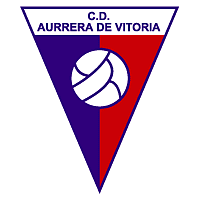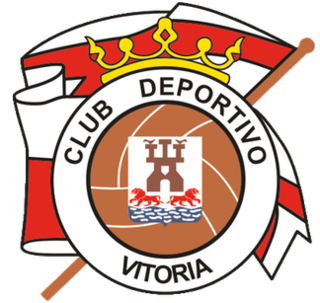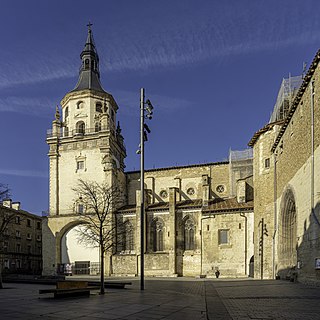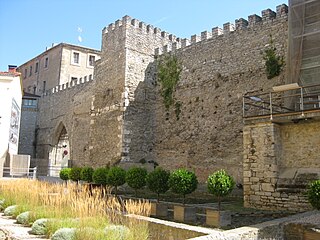
Álava or Araba, officially Araba/Álava, is a province of Spain and a historical territory of the Basque Country, heir of the ancient Lordship of Álava, former medieval Catholic bishopric and now Latin titular see.

Vitoria-Gasteiz is the seat of government and the capital city of the Basque Country and of the province of Álava in northern Spain. It holds the autonomous community's House of Parliament, the headquarters of the Government, and the Lehendakari's official residency. The municipality—which comprises not only the city but also the mainly agricultural lands of 63 villages around—is the largest in the Basque Country, with a total area of 276.81 square kilometres (106.88 sq mi), and it has a population of 253,093. The dwellers of Vitoria-Gasteiz are called vitorianos or gasteiztarrak, while traditionally they are dubbed babazorros.

Euskotren Tranbia is the brand under which the tramway networks in the cities of Vitoria-Gasteiz and Bilbao are run. The system in Bilbao started operations in 2002, and the one in Vitoria-Gasteiz in 2008. It is one of the four commercial divisions under which Euskotren operates. The infrastructure is owned by the public entity Euskal Trenbide Sarea and tracks use 1,000 mm narrow gauge.

Agurain in Basque or Salvatierra in Spanish is a town and municipality located in the province of Álava in the Basque Autonomous Community, northern Spain. The municipality, numbering 4,986 inhabitants (2015), is in turn the head town of the district or Cuadrilla of Salvatierra. The gross income per family amounts to 6,784 €. With reference to workforce by economic sectors, 10.36% are employed in agriculture, 35.78% in the industry sector, 47.92% in the service sector and 5.95% in the construction industry.

Condado de Treviño is a municipality in the province of Burgos, autonomous community of Castile and León, Spain. This municipality and the geographically smaller La Puebla de Arganzón make up the enclave of Treviño. Although the enclave is part of Burgos it is surrounded by the province of Álava, part of the autonomous community of the Basque Country. The seat of the municipality is Treviño.

Club Deportivo Aurrerá de Vitoria is a Spanish sports club based in Vitoria-Gasteiz, Álava, in the autonomous community of the Basque Country. Founded in 1935 it currently plays in División de Honor, holding home matches at Estadio Olaranbe, with a 4,000-seat capacity.
The Copa del Rey 2007-08 was the 72nd edition of the Spanish basketball Cup. It was organized by the ACB and was disputed in Vitoria-Gasteiz, Basque Country in the Fernando Buesa Arena between days 7 and 10 of February. The winning team was DKV Joventut.

Club San Ignacio is a football team based in Vitoria-Gasteiz in the autonomous community of the Basque Country. Founded in 1964, the team plays in Tercera Federación – Group 4. Representing the district of Adurtza, the club's home ground is Adurtzabal, which has a capacity of 400 spectators.

Club Deportivo Vitoria is a football team based in Vitoria-Gasteiz, in the autonomous community of Basque Country. Founded in 1945, the club has a senior side and a full youth system within its football section, as well as a basketball section.

Salburua is a wetland habitat on the eastern outskirts of the city of Vitoria-Gasteiz in the Basque Country in Spain. The area, which is part of the city green belt, contains lakes, meadows and oak groves. It was drained in the 19th century to transform the area into farmland. Restoration work started in 1994 and has reversed this situation and now Salburua is a Ramsar Wetland of International Importance. The Salburua marshes are considered to be "the Basque country's most valuable area of wetland", according to a Fedenatur report for the European Commission in 2004.

Eskibel is a village in Álava, Basque Country, Spain. It forms part of the Southwestern Rural Zone of Vitoria-Gasteiz. It is situated 7.5 km (4.7 mi) southwest of the city in a small valley surrounded by the Mountains of Vitoria.

The Tower of Mendoza is a tower located in Vitoria-Gasteiz, Spain. It was declared Bien de Interés Cultural in 1984. The tower is strategically located between the roads of Old Castile and the Ebro river.

The Cathedral of Santa María de Vitoria is a Gothic-style, Roman Catholic cathedral located in Vitoria-Gasteiz, Basque country, Spain. It was declared Bien de Interés Cultural in 1931 and a World Heritage Site in 2015.

The Casa del Cordón is a building in Vitoria-Gasteiz, Basque Country, Spain. It was declared Bien de Interés Cultural in 1984. It was built in the 15th century by converso Juan Sánchez de Bilbao around a previously existing tower house. As of 2022, the building is the seat of the Fundación Vital, a banking foundation part of Kutxabank.

The wall of Vitoria was a walled enclosure fortified in the Middle Ages in the town of Vitoria. It was built in the late 11th century. It retains about half of the total volume, and was recovered in the early 21st century in a performance that received the award given by the organization Europa Nostra in 2010.

The Plaza de los Fueros is a plaza or square located in the city centre of Vitoria-Gasteiz, which is the capital of the Basque Country, Spain. It was built in 1979 in memory of the county code of laws named fuero in Spanish.

On March 3, 1976, the Spanish Armed Police Corps used tear gas to force striking workers out of the parish church of San Francisco de Asís in the Basque capital of Vitoria-Gasteiz. As the workers left the church, they were shot by police, resulting in five dead and 150 injured with gunshot wounds. The same police later described the events as a massacre. The event inspired Lluís Llach to write the celebrated song Campanades a morts.

Borinbizkarra is a sector located to the northeast of the District of Zabalgana, in the city of Vitoria, Basque country, Spain. Borinbizkarra has an area of 343.505 square meters.

Okina is a village of the municipality of Bernedo, in the province of Álava in the Basque Country of Spain, situated about 15 kilometres (9.3 mi) from Vitoria-Gasteiz. Its population as of 2014 is 29.

Errekaleor is a neighbourhood on the periphery of Vitoria-Gasteiz, in the Basque Country, Spain. It sits on the plateau created by the Errekaleor river, which is part of the Green Belt of Vitoria-Gasteiz. From 2013 onwards, the area was occupied by squatters and became known as Errekaleor Bizirik. The project is based on the principles of workers' self-management, consensus based decision making, feminism, anti-capitalism and Basque cultural re-invigoration. The neighbourhood is the largest occupied space of its type on the Iberian Peninsula, with over 10 hectares of land and 150 inhabitants. Residents include children, the elderly, blue-collar workers, the unemployed, students, and teachers. The project includes an organic farm of 2 hectares, a bakery, a bar, a social centre, a library, a theatre, a free shop, a recording studio, and other projects.




















